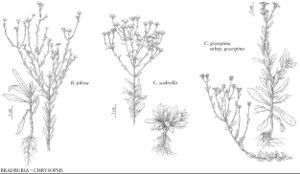Chrysopsis gossypina subsp. gossypina
Biennials or short-lived perennials, 10–100 cm. Stems 1–5+, procumbent to erect, simple or branched. Leaves: mid to distal cauline 20–40, sometimes crowded, blades broadly lanceolate, oblong, or ovate, margins sparsely to densely woolly or sometimes distal cauline eciliate (forma trichophylla), faces sparsely to densely woolly, distal sometimes glabrate (forma trichophylla). Heads (few) in lax corymbiform arrays. Phyllaries: apices appressed to squarrose, faces usually sparsely to densely woolly or sparsely pilose and densely stipitate-glandular, rarely glabrous or glabrate (forma trichophylla). 2n = 18.
Phenology: Flowering Sep (n)–Nov (s).
Habitat: Sandy, open areas, oak pine scrub, fields, roadsides
Elevation: 0–100 m
Distribution

Fla., Ga., N.C., S.C., Va.
Discussion
Subspecies gossypina is found on the Florida peninsula and on the inner and outer Atlantic coastal plains. It is highly variable in indument and phyllary traits. The extremes are recognized as three forms: forma gossypina has sparsely to densely woolly leaves and phyllaries; forma decumbens (Chapman) Godfrey has densely stipitate-glandular, sparsely pilose phyllaries, and cypselae without translucent ridges; and forma trichophylla (Nuttall) Semple has glabrous or glabrate distal cauline leaves and phyllaries. The forms are scattered throughout the range. Forma gossypina is most common from northern Georgia to Virginia. Forma trichophylla in pure form is sufficiently distinct that it has been treated as a species; it is more common in the southern part of the range of the subspecies; dune plants in the Carolinas can be very similar to subsp. cruiseana. Forma decumbens is known from the type locality in Gulf County, Florida, along the fall-line counties in the Carolinas, and near the coast in South Carolina. It can be very similar to Chrysopsis godfreyi forma godfreyi.
Selected References
None.
